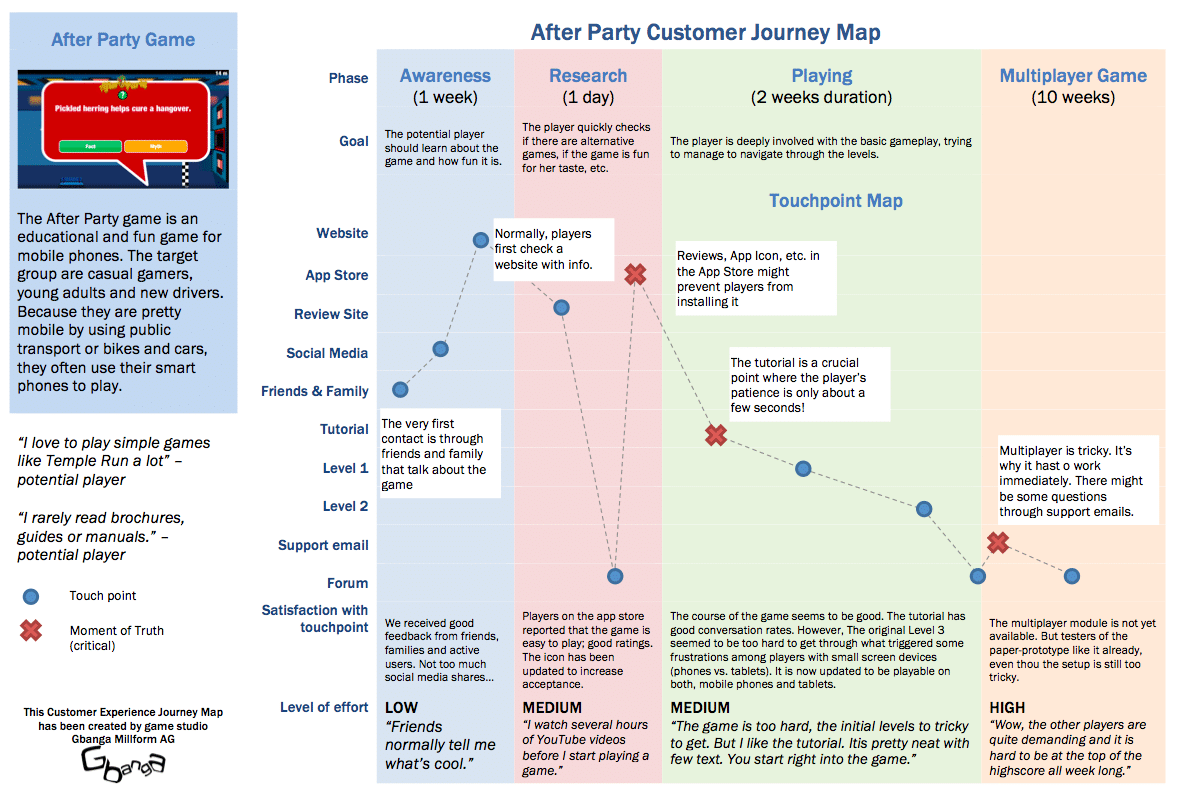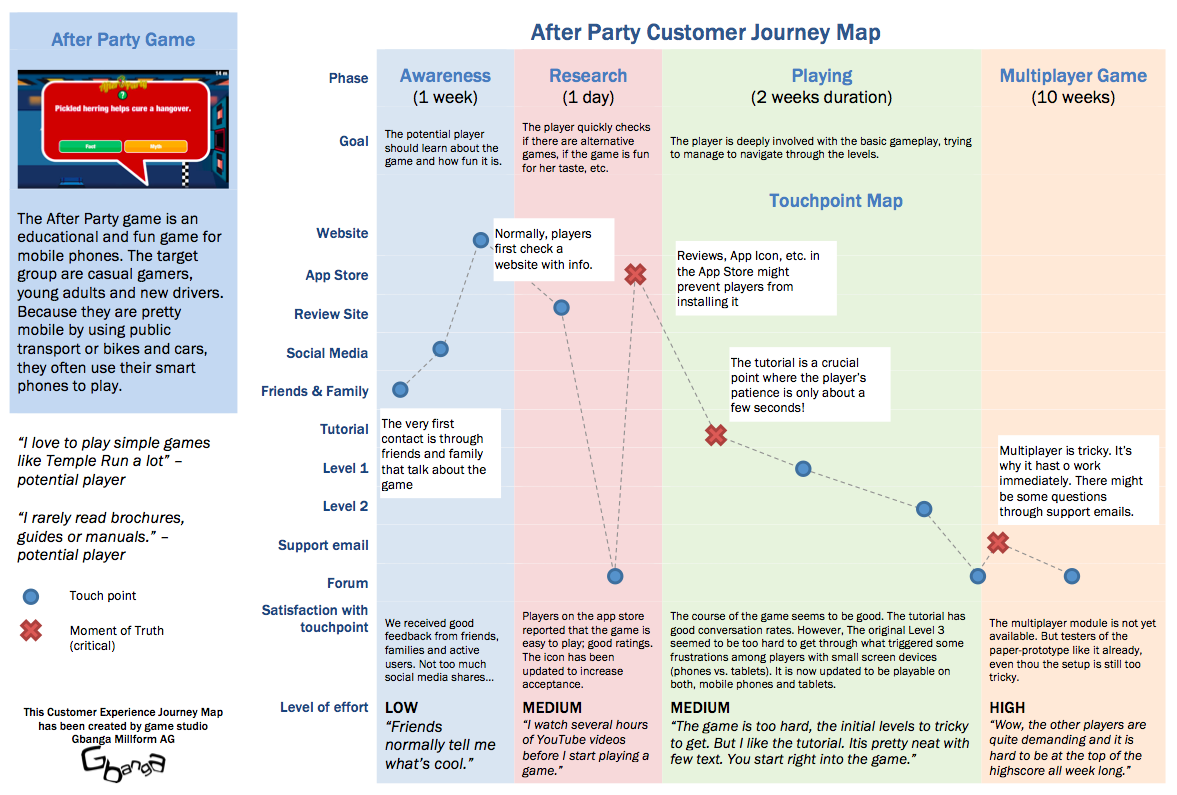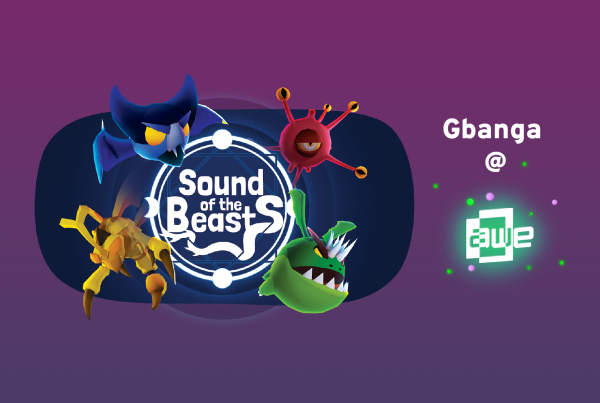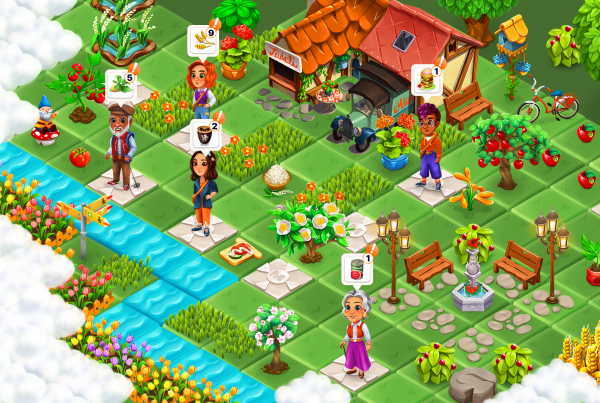Gbanga Millform AG is a dedicated game studio and pioneer in location-based mixed-reality mobile games and ad games which win international prizes and are regularly featured in App Stores. In this blog, we write intermittently about aspects in game design and game production.
This page is updated from time to time.
Game Documents
There is a long tradition and debate how games are specified and written down in text to define not only the game idea and game mechanic, but also the look and feel of a game.
We at Gbanga have noticed that Customer Journey Maps or Player Journey Maps are a helpful and relevant tool to envision the player’s emotional and functional path throughout a game. The advantage of using the theory of Customer Journey is that it is originally widely used in product design and marketing and therefore well described with plenty of tools and worksheets available online.
What is Customer Journey?
Interestingly, even thou «Customer Journey» is an english term, it seems to be more widely used in the german speaking part of the world. It is considering the following components:
- the user journey in a product which considers usability and UX issues
- the customer engagement with a brand, service
- the touchpoints in different media and situations
- the emotion and motivation of the customer
- multi-channel management in case there is cross-media such as internet, apps, print, etc. involved
How does it translate to games?
The idea of the Customer Journey is that the customer or player is setting off on a journey with a product or a service:
- Initially completely unaware, the user discovers a brand or offering in the awarenessphase. Awareness in games is triggered through word-of-mouth, game reviews, advertising, etc.
- Aware users then enter the favorability phase that then belief in the offering and investigate further. Players in favour of a specific genre or game then evaluate the best game in that genre, watches gameplay videos on YouTube, etc.
- In the consideration phase, the customer considers the purchase. She then checks the pricing at different shops, availability, required peripherals, hardware, etc.
- In the intent of purchase phase, the customer already decides where to purchase (cheapest place, best service, etc.). In games, the player might decide to go to a certain retailer store nearby his house that has the unit available.
- Conversion is the phase, where the purchase is made. The player buys the game and (hopefully) immediately starts playing it.
Of course, this funnel concept translates in different abstractions layers. The interpretation above looks at the purchasing process of a regular console game purchase.
One can also look at Freemium games and the journey within the game.
And, as we do it at Gbanga, the tool can be used completely without monetary purchases in mind, but only with conversion to play and spend time within the game.
The Player Journey Map
The Customer Journey Map or Player Journey Map is best drawn on a whiteboard or on a flip-chart (or in a graphics editing program). Fans of the famous Business Model Canvasmethod are well aware that the creation of such a map is a collective task and therefore, large whiteboards are better than electronic programs. Post-its and pin board notes are also a quick way to move and modify the map.
The map normally consists of a horizontal arrow from left to right that indicates the temporal sequence of happenings on the customer’s journey. The different phases described above are laid out on the horizontal axis from left to right: Awareness, Favorability, … Conversion. For a mobile game, the following phases could be used:Internet research, App Store, Game Installed, Game Tutorial, First Level, …, Game Over.
On the vertical axis, there is more freedom to the individual needs of the game designer. If you are focusing on emotions, you can take the followings:
- Goals: what should be achieved in this phase?
- Motivations: why would the player want to do this?
- Questions: what might be not clear to the player?
- Barriers: what could prevent the player from advancing? What could be frustrating?
- Touchpoints: when, how, why and with what is the player in touch? Is it the manual? Or the joystick or the support hotline?
The resulting grid is then filled with the answers.
An emotional roller coaster
The row for touchpoints can then be filled with a path over a bunch of media channels or screens. One can also rate the touch points to be critical decision points (moments of truth) or softer interactions. The simple example graphic above shows such an emotional roller coaster for our recent game After Party.
Flexibility, creativity, communication
The concept of Customer Journey Maps, Player Journey Maps or «Player’s Journey» (as Amy Jo Kim calls it) is very flexible and can be applied very creatively without being to strict about the columns and row labels. It is a great source for discussions among the team and also a great opportunity to be on the same page.
Possible axis labels include tutorial steps, levels, experience levels, dialog sequences (in adventure games), game overs, etc.
How to start— hands-on pro tips
Readers of this blog post have pointed out that it’s important to have tools to get started crafting your player journey map. In this Q&A section we answer your questions with hands-on advice. This is updated from time to time.
What is the procedure to depict a journey map? Is it after you create the personas that you devise a journey map?
Yes, we [at Gbanga] normally define target groups with personas. That helps the team involved to cover all scenarios of usage. It’s important to think of places where players might play your game: students at the bus stop on their way to university for a few minutes with only one hand available because they hold a cappuccino with the other hand, etc.
Do you need to carry out an interview in order to devise a journey map? How do you gather data (over a period of time)?
Now after creating the journey map, how do you use the info to design the prototype?
Once, you do have the map polished to a state you are comfortable with, you can use the scenarios and paths for UX and UI sketches. For each player journey, and for each view / dialog, ask yourself if the view / dialog caters towards the goals of the player in all scenarios. Does your game allow to enter the game quickly for very short play sessions? Is it playable with the number of hands, fingers, controllers at hand? Is the contrast of the visualization strong enough for a sunny day outside?
Need help?
If you need help with your game and your Player Journey Map, feel free to contact me directly at matthias@gbanga.com or through the form below:
[nm-mc-form fid=”2″]






